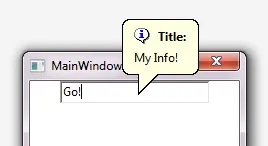我有一个使用XAML和MVVM的C# WPF应用程序。我的问题是:如何在用户输入一些无效数据时,在文本框上方显示气球工具提示?
我想使用微软的原生气球控件来实现这个功能。我该如何将其集成到我的应用程序中呢?
我有一个使用XAML和MVVM的C# WPF应用程序。我的问题是:如何在用户输入一些无效数据时,在文本框上方显示气球工具提示?
我想使用微软的原生气球控件来实现这个功能。我该如何将其集成到我的应用程序中呢?
只需添加对System.Windows.Forms和C:\Program Files\Reference Assemblies\Microsoft\Framework.NETFramework\v4.0\WindowsFormsIntegration.dll的引用,然后执行以下操作:
WindowsFormsHost host =new WindowsFormsHost();
var toolTip1 = new System.Windows.Forms.ToolTip();
toolTip1.AutoPopDelay = 5000;
toolTip1.InitialDelay = 1000;
toolTip1.ReshowDelay = 500;
toolTip1.ShowAlways = true;
toolTip1.IsBalloon = true;
toolTip1.ToolTipIcon = System.Windows.Forms.ToolTipIcon.Info;
toolTip1.ToolTipTitle = "Title:";
System.Windows.Forms.TextBox tb = new System.Windows.Forms.TextBox();
tb.Text="Go!";
toolTip1.SetToolTip(tb, "My Info!");
host.Child = tb;
grid1.Children.Add(host); //a container for windowsForm textBox
这是一个关于在WPF中使用WinForm工具提示气球的示例:

希望能对你有所帮助!
这个 BalloonDecorator 项目 是我正在使用的一个项目,用于显示帮助提示和错误通知。我知道您可以修改错误模板以显示此装饰器,就像您可以显示图标而不是红色边框一样。使用装饰器的好处是您可以使其看起来任何你想要的,并且不必依赖 WinForms。
BalloonDecorator.cs
using System;
using System.Windows;
using System.Windows.Controls;
using System.Windows.Media;
namespace MyNamespace
{
public class BalloonDecorator : Decorator
{
private static double _thickness = 0;
private static int OpeningGap = 10;
public static readonly DependencyProperty BackgroundProperty =
DependencyProperty.Register("Background", typeof (Brush), typeof (BalloonDecorator));
public static readonly DependencyProperty BorderBrushProperty =
DependencyProperty.Register("BorderBrush", typeof (Brush), typeof (BalloonDecorator));
public static readonly DependencyProperty PointerLengthProperty =
DependencyProperty.Register("PointerLength", typeof (double), typeof (BalloonDecorator),
new FrameworkPropertyMetadata(10.0, FrameworkPropertyMetadataOptions.AffectsRender |
FrameworkPropertyMetadataOptions.AffectsMeasure));
public static readonly DependencyProperty CornerRadiusProperty =
DependencyProperty.Register("CornerRadius", typeof (double), typeof (BalloonDecorator),
new FrameworkPropertyMetadata(10.0, FrameworkPropertyMetadataOptions.AffectsRender |
FrameworkPropertyMetadataOptions.AffectsMeasure));
public Brush Background
{
get { return (Brush) GetValue(BackgroundProperty); }
set { SetValue(BackgroundProperty, value); }
}
public Brush BorderBrush
{
get { return (Brush) GetValue(BorderBrushProperty); }
set { SetValue(BorderBrushProperty, value); }
}
public double PointerLength
{
get { return (double) GetValue(PointerLengthProperty); }
set { SetValue(PointerLengthProperty, value); }
}
public double CornerRadius
{
get { return (double) GetValue(CornerRadiusProperty); }
set { SetValue(CornerRadiusProperty, value); }
}
protected override Size ArrangeOverride(Size arrangeSize)
{
UIElement child = Child;
if (child != null)
{
double pLength = PointerLength;
Rect innerRect =
Rect.Inflate(new Rect(pLength, 0, Math.Max(0, arrangeSize.Width - pLength), arrangeSize.Height),
-1 * _thickness, -1 * _thickness);
child.Arrange(innerRect);
}
return arrangeSize;
}
protected override Size MeasureOverride(Size constraint)
{
UIElement child = Child;
Size size = new Size();
if (child != null)
{
Size innerSize = new Size(Math.Max(0, constraint.Width - PointerLength), constraint.Height);
child.Measure(innerSize);
size.Width += child.DesiredSize.Width;
size.Height += child.DesiredSize.Height;
}
Size borderSize = new Size(2 * _thickness, 2 * _thickness);
size.Width += borderSize.Width + PointerLength;
size.Height += borderSize.Height;
return size;
}
protected override void OnRender(DrawingContext dc)
{
Rect rect = new Rect(0, 0, RenderSize.Width, RenderSize.Height);
dc.PushClip(new RectangleGeometry(rect));
dc.DrawGeometry(Background, new Pen(BorderBrush, _thickness), CreateBalloonGeometry(rect));
dc.Pop();
}
private StreamGeometry CreateBalloonGeometry(Rect rect)
{
double radius = Math.Min(CornerRadius, rect.Height / 2);
double pointerLength = PointerLength;
// All the points on the path
Point[] points =
{
new Point(pointerLength + radius, 0), new Point(rect.Width - radius, 0), // Top
new Point(rect.Width, radius), new Point(rect.Width, rect.Height - radius), // Right
new Point(rect.Width - radius, rect.Height), // Bottom
new Point(pointerLength + radius, rect.Height), // Bottom
new Point(pointerLength, rect.Height - radius), // Left
new Point(pointerLength, radius) // Left
};
StreamGeometry geometry = new StreamGeometry();
geometry.FillRule = FillRule.Nonzero;
using (StreamGeometryContext ctx = geometry.Open())
{
ctx.BeginFigure(points[0], true, true);
ctx.LineTo(points[1], true, false);
ctx.ArcTo(points[2], new Size(radius, radius), 0, false, SweepDirection.Clockwise, true, false);
ctx.LineTo(points[3], true, false);
ctx.ArcTo(points[4], new Size(radius, radius), 0, false, SweepDirection.Clockwise, true, false);
ctx.LineTo(points[5], true, false);
ctx.ArcTo(points[6], new Size(radius, radius), 0, false, SweepDirection.Clockwise, true, false);
// Pointer
if (pointerLength > 0)
{
ctx.LineTo(rect.BottomLeft, true, false);
ctx.LineTo(new Point(pointerLength, rect.Height - radius - OpeningGap), true, false);
}
ctx.LineTo(points[7], true, false);
ctx.ArcTo(points[0], new Size(radius, radius), 0, false, SweepDirection.Clockwise, true, false);
}
return geometry;
}
}
}
请确保将此类的命名空间加载到XAML导入中(我使用一个名为“Framework”的命名空间),这样就很容易使用了:
<Framework:BalloonDecorator Background="#FFFF6600" PointerLength="50"
CornerRadius="5" Opacity=".9" Margin="200,120,0,0"
HorizontalAlignment="Left" VerticalAlignment="Top" Visibility="{Binding UnitPriceChangedBalloonVisibility}">
<Border CornerRadius="2">
<Border CornerRadius="2">
<Button Height="Auto" Command="{Binding CloseUnitPriceChangedBalloonCommand}" Background="Transparent" BorderBrush="{x:Null}">
<TextBlock Text="Please review the price. The Units have changed."
HorizontalAlignment="Left"
VerticalAlignment="Top"
FontStyle="Italic"
TextWrapping="Wrap"
Margin="10"
/>
</Button>
</Border>
</Border>
</Framework:BalloonDecorator>
也许你可以使用 WindowsFormsHost 类型在 WPF 中托管 Windows 表单控件。
MSDN 上有一篇可供参考的指南,介绍如何实现:
通过这种技术,你或许可以使用 System.Windows.Forms.ToolTip 控件。如果您将此控件的 IsBalloon property 设置为 true,则会显示成气球窗口。
System.Windows.Forms 库。 - qJake